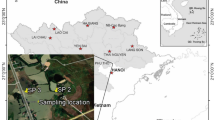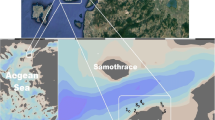Abstract
The activity concentrations of natural radionuclides (210Po and 210Pb) and residual pesticide levels were determined from the fish (red mullet, common sole, anchovy, horse mackerel, gray mullet, and sardine) and mussel samples collected in İzmir Bay seasonally from October 2012 and July 2013. The 210Po and 210Pb concentrations varied between 5.7 ± 4.0 Bq kg−1 dry weight (dw) to 353.7 ± 45.0 Bq kg−1(dw) and 0.7 ± 0.2 Bq kg−1 (dw) to 4.3 ± 0.8 Bq kg−1 (dw), respectively. From a public health point of view, the fish and mussel collected from the İzmir Bay are not harmful to consumers.


Similar content being viewed by others
References
Adu-Kumi, S., Kawano, M., Shiki, Y., Yeboah, P. O., Carboo, D., Pwamang, J., Morita, M., & Suzuki, N. (2010). Organocholorine pesticides (OCPs), dioxin-like polychlorinated biphenyls (dl-PCBs), polychlorinated dibenzo-p-dioxins and polychlorinated dibenzo furans (PCDD/Fs) in edible fish from Lake Volta, Lake Bosumtwi and Weija Lake in Ghana. Chemosphere, 81, 675–684.
Aksoy, A., Das, Y. K., Yavuz, O., Guvenc, D., Atmaca, E., & Agaoglu, S. (2011). Organochlorine pesticide and polychlorinated biphenyls levels in fish and mussel in Van region. Turkey Bulletin of Environmental Contamination and Toxicology, 87, 65–69.
Aslan, E., Görgün, A. U., Katalay S., Filizok I., Becerik S., & Aydemir T. (2018). An investigation on the seasonal variations of the biomarkers of oxidative stress response and their correlations to Polonium-210 in mussel (Mytilus galloprovincialis) and common sole (Solea solea) from İzmir Bay, Turkey. Journal of Environmental Radioactivity, 189, 103–108.
Baskaran, M. (2011). Po-210 and Pb-210 as atmospheric tracers and global atmospheric Pb-210 fallout: A review. Journal of Enviromental Radioactivity, 102, 500–513.
Bernardes, M.F.F., Pazin, M., Pereira, L.C., Dorta, D.J., (2015). Impact of pesticides on environmental and human health. Toxicology studies – Cells, drugs and environment, Andreazza, a.C. (ed.), IntechOpen, London, pp. 195-234.
Boke Ozkoc, H., Bakan, G., & Ariman, S. (2007). Distribution and bioaccumulation of organochlorine pesticides along the Black Sea coast. Environmental Geochemistry and Health, 29, 59–68.
Botaro, D., Torres, J. P. M., Malm, O., Rebelo, M. F., Henkelmann, B., & Schramm, K.-W. (2011). Organochlorine pesticides residues in feed and muscle of farmed Nile tilapia from Brazilian fish farms. Food and Chemical Toxicology, 49, 2125–2130.
Carvalho, F. P. (1995). 210Po and 210Pb intake by the Portuguese population: The contribution of seafood in the dieatry intake of 210Po and 210Pb. Health Physics, 69(4), 469–480.
Carvalho, F. P., Oliveira, J. M., & Alberto, G. (2011). Factors affecting 210Po and 210Pb activity concentrations in mussels and implications for environmental bio-monitoring programmes. Journal of Environmental Radioactivity, 102, 128–137.
Carvalho, F. P. (2011). Polonium (210Po) and lead (210Pb) in marine organisms and their transfer in marine food chains. Journal of Environmental Radioactivity, 102, 462–472.
Charmasson, S., Le Faouder, A., Loyen, J., Cosson, R. P., & Sarradin, P.-M. (2011). 210Po and 210Pb in the tissues of the deep-sea hydrothermal vent mussel Bathymodiolus azoricus from the Menez Gwen field (mid-Atlantic ridge). Science of the Total Environment, 409, 771–777.
Cherry, R. D., & Shannon, L. V. (1974). The alpha radioactivity of marine organisms. Atomic Energy Review, 12, 3–45.
Cherry, R. D., & Heyraud, M. (1981). Polonium-210 content of marine shrimp: Variation with biological and environmental factors. Marine Biology, 65, 165–175.
Cherry, R. D., Heyraud, M., & Rindfuss, R. (1994). Polonium-210 in teleost fish and in marine mammals: Interfamily differences and possible association between polonium-210 and red muscle content. Journal of Environmental Radioactivity, 24, 273–291.
Coulston, F., & Korte, F. (1974). Environmental quality and safety, global aspects of chemistry, toxicology and technology as applied to the (254pp). Environment: Academic Press.
Darko, G., Akoto, O., & Oppong, C. (2008). Persistent organochlorine pesticide residues in fish, sediments and water from Lake Bosomtwi, Ghana. Chemosphere, 72, 21–24.
Desideri, D., Meli, M. A., & Roselli, C. (2011). Natural radionuclides in seafood from the Central Adriatic Sea (Italy). Health Physics, 100(2), 160–166.
Filizok, I., & Uğur Görgün, A. (2019). Atmospheric depositional characteristics of 210Po, 210Pb and some trace elements in İzmir, Turkey. Chemosphere, 220, 468–475.
Flynn, W. W. (1968). The determination of low levels of polonium-210 in environmental materials. Analytica Chimica Acta, 43, 221–227.
Google Maps (2020). https://www.google.com.tr/maps/@38.394032,26.4406108,1252357m/data=!3m1!1e3!5m1!1e4?hl=en. Accessed 25 July 2020.
Gupta, P.K., (2007). In: Gupta, R.C. (ed.) veterinary toxicology: Basic and clinic principles. USA: Elsevier, p. 567-586.
Hurtado-Bermudez, S., Jurado-Gonzalez, J. A., Santos, J. L., Diaz-Amigo, C. F., Aparicio, I., Mas, J. L., & Alonso, E. (2018). Baseline activity concentration of 210Po and 210Pb and dose assessment in bivalve molluscs at the Andalusian coast. Marine Pollution Bulletin, 133, 711–716.
IAEA (International Atomic Energy Agency), (1995). Sources of radioactivity in the marine environment and their relative contributions to overall dose assessment from marine radioactivity (MARDOS). IAEA Technical Report Series No. 838.
Kafilzadeh, F. (2015). Assessment of Organochlorine pesticide residues in water, sediments and fish from Lake Tashk, Iran. Achievements in the Life Sciences, 9, 107–111.
Kalyoncu, L., Agca, İ., & Aktumsek, A. (2009). Some organochlorine pesticide residues in fish species in Konya. Turkey. Chemosphere, 2009(74), 885–889.
Kaur, M., Sharma, J. K., Gill, J. P., Aulakh, R. S., Bedi, J. S., & Joia, B. S. (2008). Determination of organocholorine pesticide residues in freshwater fish species in Punjab. India Bulletin of Environmental Contamination and Toxicology, 80, 154–157.
Kılıç, Ö., Belivermiş, M., Çotuk, Y., & Topçuoğlu, S. (2014a). Radioactivity concentrations in mussel (Mytilus galloprovincialis) of Turkish sea coast and contribution of 210Po to the radiation dose. Marine Pollution Bulletin, 80, 325–329.
Kılıç, Ö., Belivermiş, M., Gözel, F., & Carvalho, F. P. (2014b). Radioactivity levels in mussels and sediments of the Golden Horn by the Bosphorus Strait, Marmara Sea. Marine Pollution Bulletin, 86, 555–561.
Kim, S. H., Hong, G. H., Lee, H. M., & Cho, B. E. (2017). 210Po in the marine biota of Korean coastal waters and the effective dose from seafood consumption. Journal of Environmental Radioactivity, 174, 30–37.
Koc, F., Gurel, Y., Yigit, Y., Atamanalp, M., Das, Y. K., & Kisa, F. (2008). Screening cage culture fish species for organic chlorinated pesticide and polychlorinated biphenyl residues in Turkey. The Israeli Journal of Aquaculture-Bamidgeh, 60(4), 253–260.
Mat Çatal, E., Uğur, A., Özden, B., & Filizok, I. (2012). 210Po and 210Pb variations in fish species from the Aegean Sea and the contribution of 210Po to the radiation dose. Marine Pollution Bulletin, 64, 801–806.
McDonald, P., Fowler, S. W., Heyraud, M., & Baxter, M. S. (1986). Polonium-210 in mussels and its implications for environmental alpha-autoradiography. Journal of Environmental Radioactivity, 3, 293–303.
Okçu Pelit, F., Ertaş, H., Seyrani, I., & Ertaş, F. N. (2013). Assessment of DFG-S19 method for the determination of common endocrine disruptor pesticides in wine samples with an estimation of the uncertainty of the analytical results. Food Chemistry, 138, 54–61.
Parfenov, Y. (1974). Polonium-210 in the environment and in the human organisms. Atomic Energy Review, 12, 75–143.
Rozmaric, M., Rogic, M., Benedik, L., Strok, M., Barisic, D., & Ivsic, A. G. (2012). 210Po and 210Pb activity concentrations in Mytilus galloprovincialis from Croatian Adriatic coast with the related dose assessment to the coastal population. Chemosphere, 87, 1295–1300.
Sundar, G., Selvarani, J., Gopalakrishnan, S., & Ramachandran, S. (2010). Occurence of organochlorine pesticide residues in green mussel (Perna viridis L.) and water from Ennore creek, Chennai. India. Environmental Monitoring Assessment, 160, 593–604.
The Stockholm Convention, 2004. http://www.pops.int/TheConvention/Overview/tabid/3351/Default.aspx ().
Topcuoglu, S. (2000). Black sea ecology pollution research in Turkey of the marine environment. IAEA Bulletin, 42, 12–14.
Uddin, S., Fowler, S. W., Behbehani, M., & Metian, M. (2017). 210Po bioaccumulation and trophic transfer in marine food chains in the northern Arabian Gulf. Journal of Environmental Radioactivity, 174, 23–29.
Uddin, S., Behbehani, M., Fowler, S. W., Al-Ghadban, A., & Dupont, S. (2019). Assessment of loss of 210Po from fish and shrimp by cooking and its effects on dose estimates to humans ingesting seafood. Journal of Environmental Radioactivity, 205-206, 1–6.
Uğur, A., (1998). Gökova körfezi deniz sediment korlarında radyoaktif Pb, Po, Ra, Cs, Am ve Pu izotoplarının dağılımlarının incelenmesi, sediment hızı ve tarihleme çalışmalarında kullanılması. Ege Üniversitesi Nükleer Bilimler Enstitüsü, Doktora tezi (PhD thesis, in Turkish).
Uğur, A., Özden, B., & Filizok, I. (2011). Spatial and temporal variability of 210Po and 210Pb in mussels (Mytilus galloprovincialis) at the Turkish coast of the Aegean Sea. Chemosphere, 83, 1102–1107.
UNSCEAR (United Nations Scientific Committee on the Effects of Atomic Radiation), 2000. Sources and effects of ionizing radiation (report to the general assembly). New York.
Unsworth, J., (2010). History of pesticide use. International Union of Pure and Applied Chemistry.http://agrochemicals.iupac.org/index.php?option=com_sobi2&sobi2Task=sobi2Details&catid=3&sobi2Id=31 ().
Wang, D., Yu, Y., Zhang, X., Zhang, D., Zhang, S., & Wu, M. (2013). Organochlorine pesticides in fish from Taihu Lake, China, and associated human health risk assessment. Ecotoxicology and Environmental Safety, 98, 383–389.
Yamamoto, M., Abe, T., Kuwabara, K., Komura, K., Ueno, K., & Takizawa, Y. (1994). Polonium-210 and lead-210 in marine organisms intake: Levels for Japanese. Journal of Radioanalytical and Nuclear Chemistry, 178(1), 81–90.
Yıldız, M., Gürkan, O., Turgut, C., Kaya, Ü., Ünal, G., (2005). Tarımsal Savaşımda Kullanılan Pestisitlerin Yol Açtığı Çevre Sorunları. TMMOB Ziraat Mühendisleri 6. Teknik Kongresi, 3–7 Ocak 2005, Ankara. http://www.zmo.org.tr/resimler/ekler/dd7a04804967197_ek.pdf (Accessed 22 June 2019) (in Turkish).
Yohannes, Y. B., Ikenaka, Y., Saengtienchai, A., Watanabe, K. P., Nakayama, S. M. M., & Ishizuka, M. (2014). Concentrations and human health risk assessment of organochlorine pesticides in edible fish species from a Rift Valley lake – Lake Ziway, Ethiopia. Ecotoxicology and Environmental Safety, 106, 95–101.
Funding
This project has been partially funded by the Ege University Scientific Research Project No 12NBE017.
Author information
Authors and Affiliations
Corresponding author
Additional information
Publisher’s note
Springer Nature remains neutral with regard to jurisdictional claims in published maps and institutional affiliations.
Rights and permissions
About this article
Cite this article
Kül, M., Uğur Görgün, A. & Filizok, I. Activity concentrations of 210Po and 210Pb in fish and mussels in İzmir, Turkey, and the related health risk assessment (dose assessment and pesticide levels) to the consumers. Environ Monit Assess 192, 553 (2020). https://doi.org/10.1007/s10661-020-08486-w
Received:
Accepted:
Published:
DOI: https://doi.org/10.1007/s10661-020-08486-w




